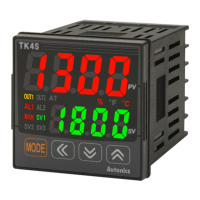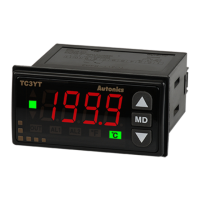6 Parameter Settings and Functions
© Copyright Reserved Autonics Co., Ltd. 85
6.4.8 Sensor Break Alarm [PAR4 → AL-1/AL-2 → SBA]
You can set the controller to send out an alarm when a sensor is not connected or
disconnected during temperature control.
Sensor break can be confirmed through an external alarm output contact, such as a
buzzer or similar means.
Setting alarm output mode (AL-□) to SBA will activate Sensor Break Alarm.
Alarm output option can be set to standard alarm (
) or alarm latch
(
).
6.4.9 Heater Burnout Alarm [PAR4 → AL-1/AL-2 → HBA]
When using a heater to raise the temperature of the control subject, the temperature
controller can be set to detect heater disconnection and send out an alarm by
monitoring power supply to the heater.
Heater disconnection is detected by the controller using a current transformer (C.T.),
which converts the current to the heater to a specific ratio (C.T. ratio) for monitoring. If
the heater current value (
CT-A) measured by the C.T. is less than the heater
detection setting value (
AL□.L), the heater burnout alarm will activate.
Heater burnout detection only takes place when the temperature
controller's output is turned on. Otherwise, heater burnout will not be
detected by the controller.
Detection is only available in models with switching output (Relay
output, SSR standard output). Models with linear output (current, SSR
cycle/phase output) are incapable of detection.
Current detection is not performed if OUT1's control output time is less
than 250 ms.
It is recommended to use Autonics designated current transformer (for
50 A).
Alarm output option can be set to standard alarm (
) or alarm latch
(
).
In the case of TK4SP models, heater burnout alarm (
) mode is not
available.

